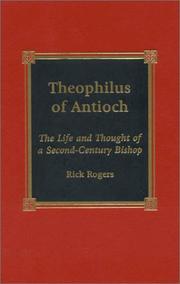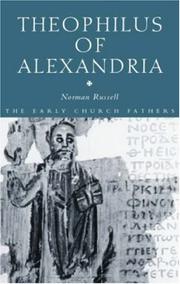| Listing 1 - 10 of 16 | << page >> |
Sort by
|
Book
Year: 1966 Publisher: Athens : Commercial Bank of Greece,
Abstract | Keywords | Export | Availability | Bookmark
 Loading...
Loading...Choose an application
- Reference Manager
- EndNote
- RefWorks (Direct export to RefWorks)
Book
Year: 1975 Publisher: London : Wildenstein,
Abstract | Keywords | Export | Availability | Bookmark
 Loading...
Loading...Choose an application
- Reference Manager
- EndNote
- RefWorks (Direct export to RefWorks)
Theophilos. --- Kontoglou, Photes. --- Ghika, Nicolas. --- Tsarouchis, Yannis.

ISBN: 9780739101322 0739101323 Year: 2000 Publisher: Lanham: Lexington books,
Abstract | Keywords | Export | Availability | Bookmark
 Loading...
Loading...Choose an application
- Reference Manager
- EndNote
- RefWorks (Direct export to RefWorks)
Theophilus, --- 276 =75 THEOPHILUS ANTIOCHENUS --- Griekse patrologie--THEOPHILUS ANTIOCHENUS --- Theophilus Saint --- Theophilos, --- Theophilus, - Saint, - 2nd cent. --- Theophilos --- Theophilus
Book
ISBN: 1498227503 9781498227506 9781625648099 Year: 2015 Publisher: Eugene, Oregon : Pickwick Publications,
Abstract | Keywords | Export | Availability | Bookmark
 Loading...
Loading...Choose an application
- Reference Manager
- EndNote
- RefWorks (Direct export to RefWorks)
New Testament scholarship uncovers much about first-century Christianity. Early Christian masters such as Origen and Augustine draw great attention to the third and following centuries. Yet oddly, despite this flood of attention to both the first century and to the third and later centuries, the second century often escapes notice, this despite its almost living memory of Jesus and his apostles from only a generation or two prior. A distinctive biblical exegesis was used by those second-century apologists who challenged Greco-Roman pagan religionists. Along with introducing the general shape of this ancient apologetic exegesis, Ancient Apologetic Exegesis aims at its recovery as well. Current literature often misunderstands or dismisses second-century exegetical approaches. But by looking behind anachronistic views of ancient genre, literacy, and rhetoric, we can rediscover a forgotten form of early Christian exegesis.
Apologetics --- History --- Theophilus, --- Theophilos, --- Bible --- Bible. --- Criticism, interpretation, etc. --- 30 - 600 --- Early Church Period --- Primitive and Early Church Period --- Theophilos --- Theophilus --- 30-600.
Book
Year: 1975 Publisher: London : Wildenstein,
Abstract | Keywords | Export | Availability | Bookmark
 Loading...
Loading...Choose an application
- Reference Manager
- EndNote
- RefWorks (Direct export to RefWorks)
Theophilos, Hadji-Michail --- Kontoglou, Fotis --- Hadjikyriakos-Ghika, Nikolas --- Tsarouchis, Yannis --- Griekenland
Book
ISBN: 9789601654713 Year: 2014 Publisher: Athēna : Patakē,
Abstract | Keywords | Export | Availability | Bookmark
 Loading...
Loading...Choose an application
- Reference Manager
- EndNote
- RefWorks (Direct export to RefWorks)
Book
ISBN: 5857592607 Year: 2004 Publisher: Moskva Indrik
Abstract | Keywords | Export | Availability | Bookmark
 Loading...
Loading...Choose an application
- Reference Manager
- EndNote
- RefWorks (Direct export to RefWorks)
Theophilos, --- Orthodox Eastern Church --- History. --- Byzantine Empire --- Istanbul (Turkey) --- Church history. --- History

ISBN: 0415289157 0415289149 9780415289153 9780415289146 9780203967553 0203967550 9781134440290 9781134440337 9781134440344 Year: 2007 Volume: *14 Publisher: London: Routledge,
Abstract | Keywords | Export | Availability | Bookmark
 Loading...
Loading...Choose an application
- Reference Manager
- EndNote
- RefWorks (Direct export to RefWorks)
Book
ISBN: 9780754664895 9781409469865 9781409469872 0754664899 1409469867 1409469867 1409469875 1317034260 9781315616025 9781317034254 9781317034261 1315616025 Year: 2014 Volume: 13 Publisher: Farnham, England ; Burlington, Vermont : Ashgate,
Abstract | Keywords | Export | Availability | Bookmark
 Loading...
Loading...Choose an application
- Reference Manager
- EndNote
- RefWorks (Direct export to RefWorks)
This book focuses on the impact of political relations with the East, especially the Muslim caliphate, on the reign of the last iconoclast emperor of Byzantium, Theophilos (829-842), reinterpreting the major events of the period and their chronology. Separate sections are devoted to the influence of Armenians at the court, the enrolment of Persian rebels against the caliphate in the Byzantine army, the continuous warfare with the Arabs and the cultural exchange with Baghdad, the Khazar problem, and the attitude of the Christian Melkites towards the iconoclast emperor. The final chapter reasses
Theophilos, --- Byzantine Empire --- Orient --- Empire byzantin --- Politics and government --- Relations --- Politique et gouvernement --- History --- Feofil, --- Theophile emp. CP --- Theophilos, - Emperor of Constantinople, - -842 --- Byzantine Empire - History - Theophilus, 829-842 --- Byzantine Empire - Politics and government - 527-1081 --- Byzantine Empire - Relations - Orient --- Orient - Relations - Byzantine Empire
Book
ISSN: 17707609 ISBN: 9782916716473 2916716475 Year: 2014 Volume: 41 Publisher: Paris: Association des amis du Centre d'histoire et civilisation de Byzance,
Abstract | Keywords | Export | Availability | Bookmark
 Loading...
Loading...Choose an application
- Reference Manager
- EndNote
- RefWorks (Direct export to RefWorks)
One of the most mysterious texts from the Second Byzantine Iconoclasm (815–843) is the so‐called Synodical Letter, purportedly sent by Patriarchs Christopher of Alexandria, Job of Antioch, and Basil of Jerusalem to Emperor Theophilos in 836. The earliest reference thereto is dated 945, whereas the oldest extant manuscript fragment is written in the ninth-century uncial. But was it a real missive or a pious forgery? Several Greek texts deriving from the lost original do not provide sufficient ground for a confident answer. Among the main problems is the lack of protocol elements indispensable for a document of this kind. Those elements, however, are present in the Slavonic text entitled Mnogosložnyj Svitok, which corresponds to Πολύστιχος τόμος in Greek. A thorough scrutiny has revealed that this is the closest version we possess to the original Letter. The Slavonic, besides indications of place (Jerusalem) and date (836) within the main text, contains two solid termini ante quos, 837 and 838, and names the actual compiler of the Letter — a certain monk Basil, who can very well be identical with the hagiographer Basil of Emesa. The latter in his Life of Theodore of Edessa claims to have attended a synod in Jerusalem, presumably that of 836.This book presents a critical edition of the Slavonic text together with corresponding Greek fragments, English translation, and Glossary. Russian translation is also attached.
Iconoclasm --- Church history --- 949.5 <093> --- Idols and images --- Geschiedenis van Byzantium en Griekenland--Historische bronnen --- History --- Worship --- Theophilos, --- Feofil, --- Byzantine Empire --- 949.5 <093> Geschiedenis van Byzantium en Griekenland--Historische bronnen --- Byzantium (Empire) --- Vizantii︠a︡ --- Bajo Imperio --- Bizancjum --- Byzantinē Autokratoria --- Vyzantinon Kratos --- Vyzantinē Autokratoria --- Impero bizantino --- Bizantia --- Iconoclasme --- Orthodoxiae festum
| Listing 1 - 10 of 16 | << page >> |
Sort by
|

 Search
Search Feedback
Feedback About UniCat
About UniCat  Help
Help News
News